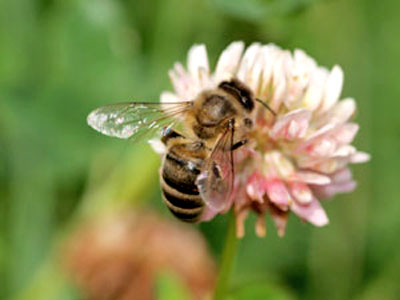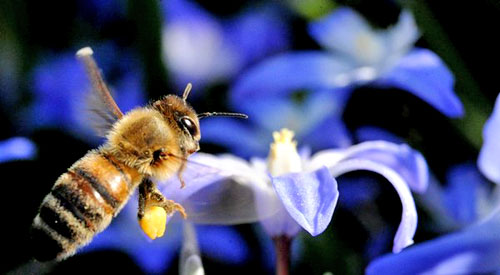|

by Sandeep Godiyal
February 13, 2013
from
NaturalNews Website
In the most recent news about neonicotinoid pesticides, it was
reported that European countries have already decided to ban the
continuous use of the pesticides because of the presented scientific
evidences showing that they continue to endanger bees.
Corporate farms in the U.S., however,
continue to ignore the petition associated to the banning of the
pesticides filed and presented by the Center for Food Safety.
This is said to lead to the continuous
decline of the bee population all over the U.S.
What are
neonicotinoid pesticides?
Neonicotinoids refer to a group of insecticides mainly composed of,
-
clothianidin
-
imidacloprid
-
fipronil
-
theamethoxam
These are widely recognized as nerve
poisons or neurotoxins that are mainly designed to damage the
central nervous system of insects, thereby leading to paralysis and
death in the most serious cases.
Among the insects targeted by these
pesticides are,
-
vine weevils
-
whitefly
-
termites
-
Colorado potato
beetle
-
aphids
Aside from being a major cause of death
and paralysis to insects, neonicotinoids are also capable of
producing other symptoms not only in target insects but other pests
and living organisms as well, including their interference with the
navigation systems of the organisms and damage their natural
capability to groom.
While the neonicotinoid pesticide is primarily designed as
non-lethal when used at low doses, it is water soluble and tends to
stay in the soil for several years. Its high level of persistency in
both water and soil may cause insects and other living organisms to
be continuously exposed to it.
Its negative impact, however, takes
place when it starts to target not only the insects that are
supposed to be deteriorated, but also those pollinators and
organisms that offer benefits to the environment.
These include not only bees but
butterflies, hoverflies, moths and aquatic invertebrates as well.
The pesticides also tend to negatively affect insect-eating birds,
amphibians and bats in an indirect manner.
This leads to the banning of the use of neonicotinoids in various
countries including those in Europe.
Neonicotinoid
pesticides and their role in the decline of bees in the U.S.
Last year, scientists in the U.S. were puzzled and alarmed by the
continued decline in bee population not only in the different states
of the U.S. but also in other countries.
But despite the evidence that shows how
damaging neonicotinoids are to bees, the U.S. still ignores the
petition of other authorized and reputable bodies and agencies to
ban or regulate the use of the pesticide.
European countries already have a tight
regulation in place when it comes to using neonicotinoids.
Based on the risk assessment process which is being considered in
the legislation of European countries, the risks of the pesticide to
honey bees are examined in full detail. The governing bodies in
Europe also continue to consider all the damaging factors of the use
of the pesticide to the bee population including the methods used in
applying them and their sub-lethal and lethal effects.
Several countries have also followed
suit by making sure that their use of
neonicotinoids are banned and
regulated not only in crops, but in household products as well.
This leads to more people persuading the
U.S. to be one with them in protecting nature's hardest workers, the
bees.
EU Proposes Neonicotinoid Pesticide Ban
by Ned Stafford
5 February 2013
from
RSC Website

The European Commission has proposed suspending the use of three
neonicotinoid pesticides on any agricultural crops that attract
bees, populations of which have steadily declined in recent decades.
The two-year suspension would apply across the EU from 1 July. It
comes just two weeks after publication of a report from the European
Food Safety Authority (EFSA) that identified ‘a number of risks
posed to bees' by three neonicotinoids.
Producers
Bayer CropScience and Syngenta strongly disputed the
findings, with Syngenta claiming the EFSA acted on ‘political
pressure to produce a hurried and inadequate risk assessment.'
But European commissioner for health and consumer policy Tonio Borg
said it was time for ‘swift and decisive action' to protect Europe's
bee populations, adding that he was initiating a,
‘set of ambitious, but proportionate
legislative measures.'
The suspension was generally applauded
by environmental groups and scientists who have argued that
neonicotinoids have contributed to the decline in bee populations.
But pesticide producers, seed companies
and farmer groups have staunchly defended the use of neonicotinoids,
saying the decline in bee population has been caused by multiple
factors and warning that a ban would hurt the EU economy and
threaten jobs.
Specifically, the measure would prohibit sale and use of,
-
clothianidin
-
thiamethoxam
-
imidacloprid,
...on crops attractive to bees,
including sunflower, rapeseed, corn and cotton.
It would similarly prohibit sale and use
of seeds treated with the three pesticides. Exceptions would include
crops and seeds that do not attract bees and winter cereals.
The Commission will review the ban in
two years.
Bayer CropScience expressed disappointment with the ‘draconian
proposal', adding that it would prefer to ‘achieve a fair and
proportional solution'.
The chemical giant said it,
‘shares the concerns surrounding bee
health and has been investing heavily in research to minimize
the impact of crop protection products on bees.'
The Commission defended the urgency of
the proposal by citing the so-called EU precautionary principle,
which allows ‘rapid response in the face of a possible danger to
human, animal or plant health, or to protect the environment'.
It is scheduled to meet with agricultural groups and industry on 7
February to discuss the proposed suspension, with a final vote
expected on 25 February by a committee of experts representing all
EU nations.
Two Studies Point to Common Pesticide as a
Culprit in...
Declining Bee Colonies
by Carl Zimmer
March 29, 2012
from
NYTimes Website
Scientists
have been alarmed and puzzled by declines in bee populations in
the United States and other parts of the world.
They have suspected that pesticides are
playing a part, but to date their experiments have yielded
conflicting, ambiguous results.
Radek
Pietruszka
European Pressphoto Agency
Protesters in Warsaw, Poland,
spoke out on March 15 against the industrialization of
farming and its effect on bees.
In Thursday's issue of the
journal Science, two teams of researchers published studies
suggesting that low levels of a common pesticide can have
significant effects on bee colonies. One experiment,
conducted by French researchers (A Common Pesticide Decreases
Foraging Success and Survival in Honey Bees), indicates that the
chemicals fog
honeybee brains, making it harder for them to find their way
home.
The other study,
by scientists in Britain (Neonicotinoid Pesticide Reduces
Bumble Bee Colony Growth and Queen Production), suggests that they keep bumblebees
from supplying their hives with enough food to produce new
queens.
The authors of both studies
contend that their results raise serious questions about the use
of the pesticides,
known as neonicotinoids.
"I personally would like to
see them not being used until more research has been done," said
David Goulson, an author of the bumblebee paper who teaches at
the University of Stirling, in Scotland.
"If it confirms what we've
found, then they certainly shouldn't be used when they're
going to be fed on by bees."
But pesticides are only one of
several likely factors that scientists have linked to declining
bee populations.
There are simply fewer flowers, for example,
thanks to land development. Bees are increasingly succumbing to
mites, viruses, fungi and other pathogens.
Outside experts were divided
about the importance of the two new studies. Some favored the
honeybee study over the bumblebee study, while others felt the
opposite was true. Environmentalists say that both studies
support their view that the insecticides should be banned.
And a scientist for
Bayer CropScience, the
leading maker of neonicotinoids,
cast doubt on both studies, for what other scientists said were
legitimate reasons.
David Fischer, an ecotoxicologist
at
Bayer CropScience, said the new experiments
had design flaws and conflicting results.
In the French study,
he said, the honeybees got far too much neonicotinoid.
"I think
they selected an improper dose level," Dr. Fischer said.
Dr. David Goulson's study on
bumblebees might warrant a "closer look," Dr. Fischer said, but
he argued that the weight of evidence still points to mites and
viruses as the most likely candidates for bee declines.
The research does not solve
the mystery of the vanishing bees. Although bumblebees have been
on the decline in the United States and elsewhere, they have not
succumbed to a specific phenomenon known as colony collapse
disorder, which affects only honeybees.
Yet the research is coming out
at a time when opposition to neonicotinoids is gaining momentum.
The insecticides, introduced in the early 1990s, have exploded
in popularity; virtually all corn grown in the United States is
treated with them. Neonicotinoids are taken up by plants and
moved to all their tissues - including the nectar on which bees
feed. The concentration of neonicotinoids in nectar is not
lethal, but some scientists have wondered if it might still
affect bees.
In the honeybee experiment,
researchers at the National Institute for Agricultural Research
in France fed the bees a dose of neonicotinoid-laced sugar water
and then moved them more than half a mile from their hive.
The
bees carried miniature radio tags that allowed the scientists to
keep track of how many returned to the hive.
In familiar territory, the
scientists found, the bees exposed to the pesticide were 10
percent less likely than healthy bees to make it home. In
unfamiliar places, that figure rose to 31 percent.
The French scientists used a
computer model to estimate how the hive would be affected by the
loss of these bees.
Under different conditions, they concluded
that the hive's population might drop by two-thirds or more,
depending on how many worker bees were exposed.
"I thought it was very well
designed," said May Berenbaum, an entomologist at the University
of Illinois at Urbana-Champaign.
But James Cresswell, an
ecotoxicologist at the University of Exeter in England, was less
impressed, because the scientists had to rely on a computer
model to determine changes in the hive.
"I don't think the paper
is a trump card," he said.
In the British study, Dr.
Goulson and his colleagues fed sugar water laced with a
neonicotinoid pesticide to 50 bumblebee colonies.
The
researchers then moved the bee colonies to a farm, alongside 25
colonies that had been fed ordinary sugar water.
At the end of each year, all
the bumblebees in a hive die except for a few new queens, which
will go on to found new hives. Dr. Goulson and his colleagues
found that colonies exposed to neonicotinoids produced 85
percent fewer queens. This reduction would translate into 85
percent fewer hives.
Jeffery Pettis, a bee expert
at the United States Department of Agriculture, called Dr. Goulson's study
"alarming." He said he suspected that other
types of wild bees would be shown to suffer similar effects.
Dr. Pettis is also convinced
that neonicotinoids in low doses make bees more vulnerable to
disease.
He and other researchers have recently published
experiments showing that neonicotinoids make honeybees more
vulnerable to infections from parasitic fungi.
|



